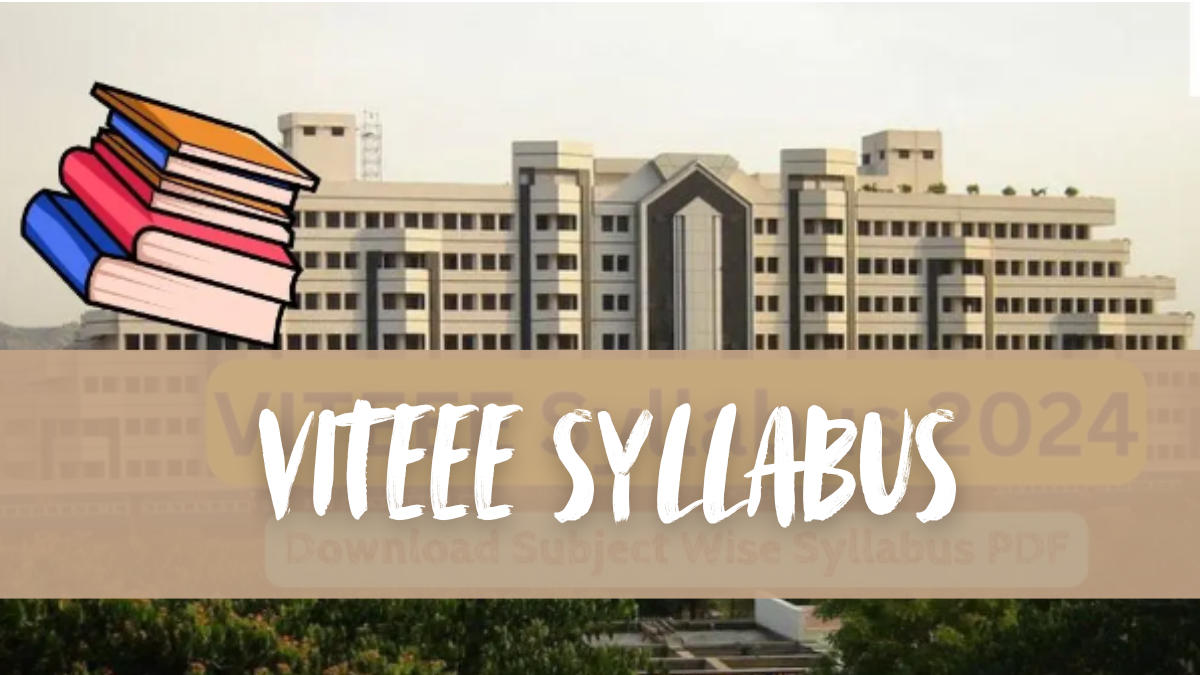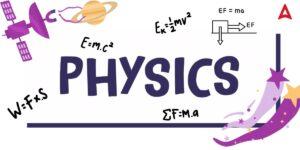Table of Contents
Vellore University has released the VITEEE syllabus 2025 for all the subjects. The latest syllabus has been published by the university on its official website at viteee.vit.ac.in. The VITEEE 2025 syllabus is important for the students who will appear for the upcoming entrance exam. The VITEEE 2025 exam will be held from April 21 to 27, 2025. Candidates need to be familiar with the VITEEE exam syllabus to sit for the VIT BTech exam in 2025.
VITEEE Syllabus 2025
The Vellore Institute of Technology released the updated VITEEE syllabus 2025 online on its official website. The detailed syllabus is given below for all the subjects. The VITEE syllabus PDF has been provided for all the subjects of the VIT Engineering exam for the convenience of students. The syllabus consists of topics from the Physics, Chemistry, Mathematics, English language, and Aptitude subjects. The weightage of the Mathematics section is the highest in the VITEEE 2025 syllabus.
VITEEE 2025 Syllabus Overview
It is recommended that candidates thoroughly review and comprehend the VITEEE 2025 syllabus to expedite their preparation. Examinees can verify key subjects and chapters asked in this exam by consulting the curriculum. The syllabus for VITEEE is comparable to that of the qualifying examination for the 12th grade. To be well-prepared for the exam, applicants are also suggested to review the VITEEE 2025 Exam pattern in addition to the syllabus.
The curriculum contains information on the subjects and concepts that must be studied to pass the VITEEE 2025 Entrance Exam. According to the curriculum, English, mathematics, physics, chemistry, and aptitude at the 10+2 standard qualifying examination level are the primary subjects that must be studied.
VITEEE Physics Syllabus 2025
Physics is an important component of the entrance exam. The VITEEE 2025 Physics syllabus consists of topics from the Class 11 and Class 12 board curricula of various boards. Some of the important chapters from the VITEEE syllabus include Optics, Electrostatics, Nuclear Physics, etc. The detailed syllabus is given below.
Laws of Motion & Work, Energy and Power
Law of conservation of linear momentum and its applications. Static and kinetic friction – laws of friction -rolling friction – lubrication. Work done by a constant force and a variable force; kinetic energy – work-energy theorem – power.
Conservative forces: conservation of mechanical energy (kinetic and potential energies) – non-conservative forces: motion in a vertical circle – elastic and inelastic collisions in one and two dimensions.
Properties of Matter
Elastic behaviour – Stress-strain relationship – Hooke’s law – Young’s modulus – bulk modulus – shear modulus of rigidity – Poisson’s ratio – elastic energy. Viscosity – Stokes’ law – terminal velocity – streamline and turbulent flow – critical velocity. Bernoulli’s theorem and its applications. Heat – temperature – thermal expansion: thermal expansion of solids – specific heat capacity: Cp, Cv – latent heat capacity. Qualitative ideas of Blackbody radiation: Wein’s displacement Law – Stefan’s law.
Electrostatics
Charges and their conservation; Coulomb’s law forces between two point electric charges – Forces between multiple electric charges-superposition principle. Electric field – electric field due to a point charge, electric field lines; electric dipole, electric field intensity due to a dipole – the behaviour of a dipole in a uniform electric field. Electric potential – potential difference-electric potential due to a point charge and dipole-equipotential surfaces – the electrical potential energy of a system of two point charges.
Electric flux-Gauss’s theorem and its applications. Electrostatic induction-capacitor and capacitance – dielectric and electric polarisation – parallel plate capacitor with and without dielectric medium – applications of capacitor – energy stored in a capacitor – Capacitors in series and in parallel – action points – Van de Graaff generator.
Current Electricity
Electric Current – the flow of charges in a metallic conductor – drift velocity and mobility and their relation with electric current. Ohm’s law, electrical resistance – V-I characteristics – electrical resistivity and conductivity-classification of materials in terms of conductivity – Carbon resistors – colour code for carbon resistors – combination of resistors – series and parallel – temperature dependence of resistance – internal resistance of a cell – potential difference and emf of a cell – combinations of cells in series and in parallel.
Kirchoff’s law – Wheatstone’s Bridge and its application for temperature coefficient of resistance measurement – Metrebridge – a special case of Wheatstone bridge – Potentiometer principle – comparing the emf of two cells.
Magnetic Effects of Electric Current
Magnetic effect of electric current – Concept of magnetic field – Oersted’s experiment – Biot-Savart low magnetic field due to an infinitely long current carrying straight wire and circular coil – Tangent galvanometer – construction and working – Bar magnet as an equivalent solenoid – magnetic field lines. Ampere’s circuital law and its application. Force on a moving charge in a uniform magnetic field and electric field – cyclotron – Force on current carrying conductor in a uniform magnetic field – Forces between two parallel current carrying conductors – definition of ampere. Torque experienced by a current loop in a uniform magnetic field – moving coil galvanometer – conversion to ammeter and voltmeter – current loop as a magnetic dipole and its magnetic dipole moment – Magnetic dipole moment of a revolving electron.
Electromagnetic Induction and Alternating Current
Electromagnetic induction – Faraday’s law – induced emf and current – Lenz’s law. Self-induction – Mutual induction – self-inductance of a long solenoid – mutual inductance of two long solenoids. Methods of inducing emf – (i) by changing magnetic induction (ii) by changing the area enclosed by the coil and (iii) by changing the orientation of the coil (quantitative treatment). AC generator – commercial generator. (Single phase, three phases). Eddy current – applications – transformer – long-distance transmission.
Alternating current – measurement of AC – AC circuit with resistance – AC circuit with inductor – AC circuit with capacitor – LCR series circuit – Resonance and Q – factor – power in AC circuits.
Optics
Reflection of light, spherical mirrors, mirror formula. Refraction of light, total internal reflection and its applications, optical fibres, refraction at spherical surfaces, lenses, thin lens formula, lens maker’s formula. Magnification, power of a lens, combination of thin lenses in contact, a combination of a lens and a mirror.
Refraction and dispersion of light through a prism. Scattering of the light-blue colour of the sky and the reddish appearance of the sun at sunrise and sunset. Wavefront and Huygens’s principle – Reflection, total internal reflection and refraction of plane wave at a plane surface using wavefronts. Interference – Young’s double slit experiment and expression for fringe width – coherent source – interference of light – Formation of colours in thin films – Newton’s rings.
Diffraction – differences between interference and diffraction of light- diffraction grating. Polarisation of light waves – polarisation by reflection – Brewster’s law – double refraction – nicol prism – uses of plane polarised light and Polaroids – rotatory polarisation – polarimeter.
Dual Nature of Radiation and Atomic Physics
Electromagnetic waves and their characteristics – Electromagnetic spectrum – Photoelectric effect – Light waves and photons – Einstein’s photoelectric equation – laws of photoelectric emission – particle nature of light – photo cells and their applications.
Atomic structure – discovery of the electron – specific charge (Thomson’s method) and charge of the electron (Millikan’s oil drop method) – alpha scattering – Rutherford’s atom model.
Nuclear Physics
Nuclear properties – nuclear radii, masses, binding energy, density, charge – isotopes, isobars and isotones – nuclear mass defect – binding energy – stability of nuclei – Bainbridge mass spectrometer.
Nature of nuclear forces – Neutron – discovery – properties – artificial transmutation – particle accelerator. Radioactivity – alpha, beta and gamma radiations and their properties – Radioactive decay law – half-life – mean life – artificial radioactivity – radio isotopes – effects and uses – Geiger – Muller counter. Radiocarbon dating. Nuclear fission – chain reaction – atom bomb – nuclear reactor – nuclear fusion – Hydrogen bomb – cosmic rays – elementary particles.
Semiconductor Devices and their Applications
Semiconductor basics – energy band in solids: difference between metals, insulators and semiconductors – semiconductor doping – Intrinsic and Extrinsic semiconductors.
Formation of P-N Junction – Barrier potential and depletion layer-P-N Junction diode – Forward and reverse bias characteristics – diode as a rectifier – Zener diode as a voltage regulator – LED. Junction transistors – characteristics – transistor as a switch – transistor as an amplifier – transistor as an oscillator.
Logic gates – NOT, OR, AND, EXOR using discrete components – NAND and NOR gates as universal gates – De Morgan’s theorem – Laws and theorems of Boolean algebra.
VITEEE Chemistry Syllabus 2025
Chemistry is another important subject component of the VITEEE syllabus. The VITEEE chemistry syllabus consists of chapters and topics from the class 11 and Class 12 curricula of the Indian education boards. The detailed syllabus for the chemistry section of the VITEEE 2025 exam is given hereunder.
Atomic Structure
Bohr’s atomic model-Sommerfeld’s extension of atomic structure; Electronic configuration and Quantum numbers; Shapes of s, p, d, f orbitals – Pauli’s exclusion principle – Hund’s Rule of maximum multiplicity- Aufbau principle. Emission spectrum, absorption spectrum, line spectra and band spectra; Hydrogen spectrum – Lyman, Balmer, Paschen, Brackett and Pfund series; de Broglie’s theory; Heisenberg’s uncertainty principle – wave nature of electron – Schrodinger wave equation (No derivation). Eigen values and eigen functions. Hybridization of atomic orbitals involving s, p, d orbitals.
p, d and f – Block Elements
p-block elements – Phosphorous compounds; PCl3, PCl5 – Oxides. Hydrogen halides, Inter halogen compounds. Xenon fluoride compounds. General Characteristics of d – block elements – Electronic Configuration – Oxidation states of first-row transition elements and their colours. Occurrence and principles of extraction: Copper, Silver, Gold and Zinc. Preparation, properties of CuSO4, AgNO3 and K2Cr2O7.
Lanthanides – Introduction, electronic configuration, general characteristics, oxidation state – lanthanide contraction, uses, brief comparison of Lanthanides and Actinides.
Coordination Chemistry and Solid State Chemistry
Introduction – Terminology in coordination chemistry – IUPAC nomenclature of mononuclear coordination compounds. Isomerism, Geometrical isomerism in 4-coordinate, 6-coordinate complexes. Theories on coordination compounds – Werner’s theory (brief), Valence Bond theory. Uses of coordination compounds. Bioinorganic compounds (Haemoglobin and chlorophyll).
Lattice – unit cell, systems, types of crystals, packing in solids; Ionic crystals – Imperfections in solids – point defects. X-Ray diffraction – Electrical Property, Amorphous solids (elementary ideas only).
Thermodynamics, Chemical Equilibrium and Chemical Kinetics
I and II law of thermodynamics – spontaneous and non-spontaneous processes, entropy, Gibb’s free energy – Free energy change and chemical equilibrium – the significance of entropy. Law of mass action – Le Chatlier’s principle, applications of chemical equilibrium. Rate expression, order and molecularity of reactions, zero order, first order and pseudo-first-order reaction – half-life period. Determination of rate constant and order of reaction. Temperature dependence of rate constant – Arrhenius equation, activation energy.
Electrochemistry
Theory of electrical conductance; metallic and electrolytic conductance. Faraday’s laws – theory of strong electrolytes – Specific resistance, specific conductance, equivalent and molar conductance – Variation of conductance with dilution – Kohlrausch’s Law – Ionic product of water, pH and pOH – buffer solutions – use of pH values. Cells – Electrodes and electrode potentials – construction of cell and EMF values, Fuel cells, Corrosion and its prevention.
Isomerism in Organic Compounds
Definition, Classification – structural isomerism, stereo isomerism – geometrical and optical isomerism. Optical activity- chirality – compounds containing chiral centres – R – S notation, D – L notation.
Alcohols and Ethers
Nomenclature of alcohols – Classification of alcohols – the distinction between 10, 20 and 30 alcohols – General methods of preparation of primary alcohols, properties. Methods of preparation of dihydric alcohols: Glycol – Properties – Uses. Methods of preparation of trihydric alcohols – Properties – Uses. Aromatic alcohols – preparation and properties of phenols and benzyl alcohol.
Ethers – Nomenclature of ethers – general methods of preparation of aliphatic ethers – Properties – Uses. Aromatic ethers – Preparation of Anisole – Uses.
Carbonyl Compounds
Nomenclature of carbonyl compounds – Comparison of aldehydes and ketones. General methods of preparation of aldehydes – Properties – Uses. Aromatic aldehydes – Preparation of benzaldehyde – Properties and Uses. Ketones – general methods of preparation of aliphatic ketones (acetone) – Properties – Uses. Aromatic ketones – preparation of acetophenone – Properties – Uses, preparation of benzophenone – Properties. Name reactions; Clemmenson reduction, Wolff – Kishner reduction, Cannizzaro reaction, Claisen Schmidt reaction, Benzoin Condensation, aldol Condensation. Preparation and applications of Grignard reagents.
Carboxylic Acids and their derivatives
Nomenclature – Preparation of aliphatic monocarboxylic acids – formic acid – Properties – Uses. Monohydroxy mono carboxylic acids; Lactic acid – Synthesis of lactic acid. Aliphatic dicarboxylic acids; Preparation of oxalic and succinic acid. Aromatic acids; Benzoic and Salicylic acid – Properties – Uses. Derivatives of carboxylic acids; acetyl chloride (CH3COCl) – Preparation – Properties – Uses. Preparation of acetamide, Properties – acetic anhydride – Preparation, Properties. Preparation of esters – methyl acetate – Properties.
Organic Nitrogen Compounds
Aliphatic nitro compounds – Preparation of aliphatic nitroalkanes – Properties – Uses. Aromatic nitro compounds – Preparation – Properties – Uses. The distinction between aliphatic and aromatic nitro compounds. Amines; aliphatic amines – General methods of preparation – Properties – Distinction between 10, 20 and 30 amines. Aromatic amines – Synthesis of benzylamine – Properties, Aniline – Preparation – Properties – Uses. The distinction between aliphatic and aromatic amine. Aliphatic nitriles – Preparation – properties – Uses. Diazonium salts – Preparation of benzene diazoniumchloride – Properties.
- Carbohydrates – the distinction between sugars and non-sugars, structural formulae of glucose, fructose and sucrose, with their linkages, invert sugar – definition, examples of oligo and polysaccharides,
- Amino acids – classification with examples, Peptides-properties of the peptide bond, Lipids – Definition, classification with examples, the difference between fats, oils and waxes.
- Lipids – Definition, classification with examples, the difference between fats, oils and waxes.
VITEEE Mathematics Syllabus 2025
Mathematics subject has the highest weightage in the VITEEE 2025 exam. Therefore, students must prepare for this subject with great care and focus. The VITEEE Math syllabus includes topics like Matrices, Vector Algebra, Probability, etc. The level of these topics is up to the Class 11 and Class 12 level of the Indian education boards. The detailed syllabus for the Mathematics section of the VITEEE exam is listed below.
Matrices and their Applications
Adjoint, inverse – properties, computation of inverses, solution of a system of linear equations by matrix inversion method. The rank of a matrix – elementary transformation on a matrix, consistency of a system of linear equations, Cramer’s rule, non-homogeneous equations, homogeneous linear system and rank method. Solution of linear programming problems (LPP) in two variables.
Trigonometry and Complex Numbers
Definition, range, domain, principal value branch, graphs of inverse trigonometric functions and their elementary properties. Complex number system – conjugate, properties, ordered pair representation. Modulus – properties, geometrical representation, polar form, principal value, conjugate, sum, difference, product, quotient, vector interpretation, solutions of polynomial equations, De Moivre’s theorem and its applications. Roots of a complex number – nth roots, cube roots, fourth roots.
Analytical Geometry of two dimensions
Definition of a conic – general equation of a conic, classification with respect to the general equation of a conic, classification of conics with respect to eccentricity. Equations of conic sections (parabola, ellipse and hyperbola) in standard forms and general forms- Directrix, Focus and Latus-rectum – a parametric form of conics and chords. – Tangents and normals – Cartesian form and parametric form- equation of chord of contact of tangents from a point (x1,y1) to all the above said curves. Asymptotes, Rectangular hyperbola – Standard equation of a rectangular hyperbola.
Vector Algebra
Scalar Product – the angle between two vectors, properties of scalar product, and applications of the dot product. Vector product, right-handed and left-handed systems, properties of vector product, applications of cross product. Product of three vectors – Scalar triple product, properties of scalar triple product, vector triple product, vector product of four vectors, scalar product of four vectors.
Analytical Geometry of Three Dimensions
Direction cosines – direction ratios – equation of a straight line passing through a given point and parallel to a given line, passing through two given points, the angle between two lines. Planes – equation of a plane, passing through a given point and perpendicular to a line, given the distance from the origin and unit normal, passing through a given point and parallel to two given lines, passing through two given points and parallel to a given line, passing through three given non-collinear points, passing through the line of intersection of two given planes, the distance between a point and a plane, the plane which contains two given lines (co-planar lines), angle between a line and a plane. Skew lines – the shortest distance between two lines, condition for two lines to intersect, point of intersection, collinearity of three points. 2 Sphere – equation of the sphere whose centre and radius are given, equation of a sphere when the extremities of the diameter are given.
Differential Calculus
Limits, continuity and differentiability of functions – Derivative is a rate of change, velocity, acceleration, and related rates, and derivative as a measure of slope, tangent, normal and angle between curves. Mean value theorem – Rolle’s Theorem, Lagrange Mean Value Theorem, Taylor’s and Maclaurin’s series, L’ Hospital’s Rule, stationary points, increasing, decreasing, maxima, minima, concavity, convexity and points of inflexion. Errors and approximations – absolute, relative, percentage errors – curve tracing, partial derivatives, Euler’s theorem.
Integral Calculus and its Applications
Simple definite integrals – fundamental theorems of calculus, properties of definite integrals. Reduction formulae – reduction formulae for x dx n sin and x dx n cos, Bernoulli’s formula. Area of bounded regions, length of the curve.
Differential Equations
Differential equations – formation of differential equations, order and degree, solving differential equations (1st order), variables separable, homogeneous and linear equations. Second-order linear differential equations – second-order linear differential equations with constant coefficients, finding the particular integral if f(x) = emx, sin mx, cos mx, x, x2.
Discrete Mathematics
Functions – Relations – Basics of counting. Mathematical logic – logical statements, connectives, truth tables, logical equivalence, tautology, a contradiction. Groups-binary operations, semi-groups, monoids, groups, order of a group, order of an element, properties of groups
Probability Distributions
Probability – Axioms – Addition law – Conditional probability – Multiplicative law – Baye’s Theorem – Random variable – probability density function, distribution function, mathematical expectation, variance Theoretical distributions – discrete distributions, Binomial, Poisson distributions- Continuous distributions, Normal distribution.
VITEEE English Syllabus 2025
Multiple-choice questions on English will assess knowledge of English grammar and pronunciation as well as understanding of a brief paragraph or line of poetry. Please be aware that the dialogue, poetry lines, passages, grammar, and pronunciation elements have been selected to correspond to the higher secondary or equivalent educational level.
VITEEE Syllabus For Aptitude
Candidates taking the VITEEE exam will also be asked questions from the aptitude section. The syllabus for the VITEEE exam’s aptitude section is given below.
- Data Interpretation
- Data Sufficiency
- Syllogism
- Number Series, Coding and Decoding
- Clocks, Calendars, and Directions
VITEEE Syllabus 2025 PDF Download
The subject-wise pdf for different subjects of the VITEEE 2025 syllabus is given below for download. Students can get the syllabus PDF by clicking the link given below.
| PDF LInks |
| Download VITEEE 2025 Physics Syllabus PDF |
| Download VITEEE 2025 Chemistry Syllabus PDF |
| Download VITEEE 2025 Mathematics Syllabus PDF |
| Download VITEEE 2025 English and Aptitude Syllabus PDF |
Best VITEEE 2025 Books
The importance of the standard books for the competition is significant as they contain the right set of questions and relevant study material for the exam. Students preparing for the VITEEE exam 2025 must follow the standard books given below. The list of important books and their author has been given below subject-wise.
Important Books for Physics
| Book Name | Author |
| Concept of Physics Part-1 & Part-2 | H.C. Verma |
| Problems in General Physics | I.E. Irodov |
| Understanding Physics Series | D.C. Pandey |
Important Books for Chemistry
| Book Name | Author |
| Handbook of Chemistry | R.P. Singh |
| Textbook for Class XI & XII | NCERT |
| Organic Chemistry | O. P. Tandon & Morrison Boyd. |
| Modern Approach to Chemical Calculations | R. C. Mukherjee |
Important Books for Mathematics
| Book Name | Author |
| Higher Algebra | Hall and Knight |
| Degree level Differential Calculus | A Das Gupta |
| Target VITEEE | Disha Experts |
| Objective Mathematics Part 1 and Part 2 | R.D. Sharma |
| Problems in Calculus of One Variable | I.A. Maron |
VITEEE 2025 Exam Pattern
The VITEEE exam pattern is likely to remain the same as the previous year. The official website of Vellore Institute of Technology will be used to announce the VITEEE exam pattern. In addition to the VIT syllabus 2025, candidates hoping to sit for the upcoming VITEEE exam should be aware of the official exam pattern. They will be better prepared for the VITEEE exam by having a proper understanding of the test pattern. The VITEEE exam pattern is given below.
| Particulars | Details |
| Examination Mode | Online – Computer Based Test |
| Duration of Exam | 2 hours 30 minutes |
| Sections | Mathematics – 40 Questions |
| Physics – 35 Questions | |
| Chemistry – 35 Questions | |
| Aptitude – 10 Questions | |
| English – 5 Questions | |
| Type of Questions | Objective – Multiple Choice Questions (MCQs) |
| Total Number of Questions | 125 questions |
| Marking Scheme | For each correct response, one mark will be awarded |
| Negative Marking | There is no provision for negative marking in VITEEE 2025 |




 NEET Botany Syllabus 2025 Out, Check Cha...
NEET Botany Syllabus 2025 Out, Check Cha...
 CUET Science Syllabus 2025 Out, Download...
CUET Science Syllabus 2025 Out, Download...
 CUET Physics Syllabus 2025 PDF Download ...
CUET Physics Syllabus 2025 PDF Download ...










